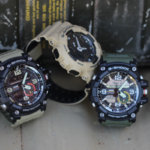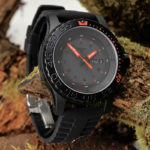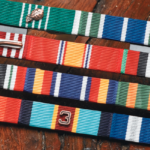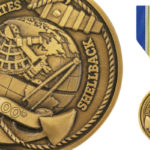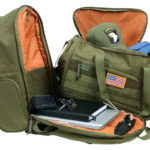Army Combat Infantry Badge Description: A silver and enamel Army badge 1 inch in height and 3 inches in width, consisting of an infantry musket on a light blue bar with a silver border, on and over an elliptical oak wreath. Stars are added at the top of the wreath to indicate subsequent awards; one star for the second award, two stars for the third award and three stars for the fourth award. Note: If issued during World War II it is automatic authorization for the Bronze Star Medal (F018).
Symbolism: The bar is blue, the color associated with the Infantry branch. The musket is adapted from the Infantry insignia of branch and represents the first official U.S. shoulder arm, the 1795 model Springfield Arsenal musket. It was adopted as the official Infantry branch insignia in 1924. The oak symbolizes steadfastness, strength and loyalty.
Award Eligibility: Awarded to personnel in the grade of Colonel or below with an infantry military occupational specialty who have satisfactorily performed duty while assigned as a member of an infantry unit, brigade or smaller size, after 6 December 1941, when engaged in active ground combat. Expanded to permit award to Command Sergeants Major of infantry battalions or brigades, effective 1 January 1967. Specific criteria for each conflict was also established. Only one award is authorized for service in Vietnam, Laos, Dominican Republic, Korea (subsequent to 27 July 1954), Grenada, Panama, and Southwest Asia. The complete criteria for each area and inclusive dates are listed in Army Regulation 600-8-22.
Date Approved: The Army Combat Infantry Badge was approved by the Secretary of War on 7 October 1943, and was initially referred to as the Combat Assault Badge; however, the name was changed to the Combat Infantryman Badge as announced in War Department Circular 269 dated 27 October 1943. On 8 February 1952, the Chief of Staff, Army, approved a proposal to add stars to the Army Combat Infantry Badge to indicate award of the badge in separate wars. Under this change in policy, the badge was no longer limited to a one-time award, but may now be awarded to eligible individuals for each war in which they participated.
Subdued Badges: Subdued badges are authorized in metal and cloth. The metal badge has a black finish. The cloth badge has olive green base cloth with the rifle, wreath, stars and border of the bar embroidered in black.
Miniature Badges: A dress miniature badge, 1-1/4 inches in length is authorized for wear on the mess uniforms. A miniature badge, 1-3/4 inches is also authorized in lieu of the regular size badge.
Remarks: Military Actions covered by the CIB:
World War II: Dec 7, 1941 – Sept 3, 1945
Korean War: Jun 27, 1950 – July 27, 1953
Laos: April 19, 1961 – Oct 6, 1962
Vietnam: March 1, 1961 – March 29, 1973
Dominican Republic: April 28, 1965 – Sept 1, 1966
Korea DMZ: Jan 4, 1969 – but before Mar 31, 1994
El Salvador: Jan 1, 1981 – Feb 1, 1992
Grenada: Oct 23, 1983 – Nov 21, 1983
Panama: Dec 20, 1989 – Jan 31, 1990
Persian Gulf War: Jan 17, 1991 – April 11, 1991
Somalia: June 5, 1993 – March 31,1994
Kosvo:
Afghanistan:
Iraq:
Medals of America carries a large selection of Army Caps, Military Patches and Army Medals. Also, be sure to use our exclusive Ribbon Rack Builder to update your Traditional Military Ribbons and Thin Ribbons mounted for wear.
